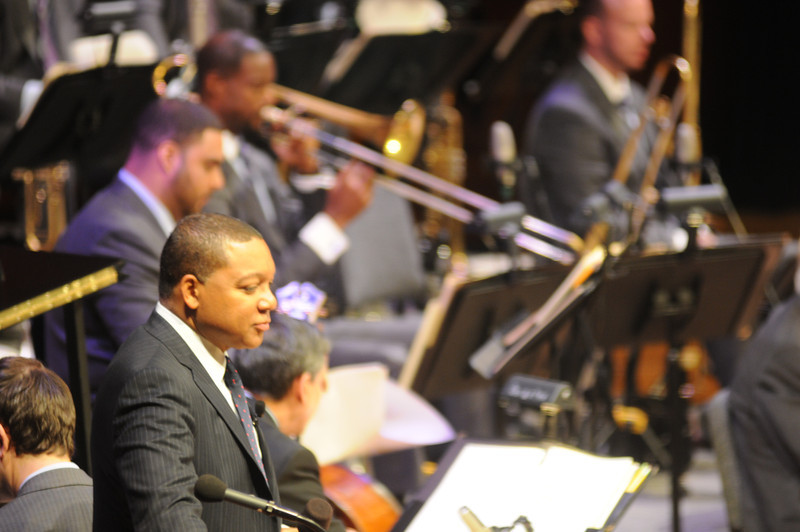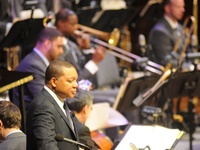Excitement abounded in Sanders Theatre last Thursday night as hundreds of students, Cambridge residents, and visitors waited to see Wynton Marsalis perform and speak about jazz history. Marsalis is an accomplished, Grammy award-winning trumpeter recognized by the United Nations and the U.S. State Department for his contributions to music and culture.
Accompanied by the Jazz at Lincoln Center Orchestra, Marsalis returned to Harvard for the fifth time on Thursday, continuing his popular and sold-out musical lecture series “Hidden in Plain View: Meanings in American Music.” Each lecture has taken a unique approach to the study of jazz music, highlighting facets of performance like the intersection of music and dance.
This time around, in “Setting the Communal Table: The Evolution of Jazz Orchestra,” Marsalis fused his lively accounts of jazz history with the Lincoln Center Orchestra’s renditions of popular music pieces, including those by Duke Ellington, Louis Armstrong, and Fletcher Henderson.
Following a warm welcome from the crowd, Marsalis dove right into personal stories, including a detailed account of the first time he played a French horn. He also touched on broader themes, including descriptions of how the traditions and hardships of black culture influenced the spread of jazz music. Marsalis explained that the struggles of black Americans shaped the lyrics, style, and popularity of jazz. He also said that ballroom dancing and the social scene of the 1920s encouraged and was encouraged by the jazz music of the age.
"He also hit on a lot of important cultural items too, talking about the historical leadership of jazz musicians in racial desegregation," says Daniel A. Henderson, a lecturer in the department of music specializing in jazz harmony and improvisation. “I feel like it was billed as a lecture but it was like a lecture/sermon/concert, which is the ultimate learning combination to me."
Beyond his anecdotal recounting of the music’s social and cultural history, Marsalis demonstrated the intricacies and histories behind trombones, reeds, and trumpets. As the orchestra played, Marsalis narrated what they were performing, highlighting subtleties and helping the audience appreciate the complexity of all the instruments in the ensemble. Marsalis asked the orchestra to play different 1920s jazz hits in parts, adding and subtracting instruments to show the effect of each.
"He got into serious musical detail which is really exciting for me and for the class,” Henderson says. “He was talking about the evolution of instrumentation and jazz arranging. You hardly ever get to hear someone so in depth about instrumentation and arranging."
Read more in Arts
Artist Spotlight: Nicole AquillanoRecommended Articles
-
Wynton Marsalis To Teach JazzAs part of University President Drew G. Faust’s effort to promote the arts, the University announced April 4 that renowned ...
-
Marsalis Brings Jazz and Metaphor to Sanders TheatreWhy jazz? Wynton Marsalis’ answer is simple: “Because it’s the national art.” For him, jazz is perfectly suited by its history and its structure to be morphed and meatphorized as an expression of the American identity.
-
 Marsalis on Dance—The 'Big Sister of Music'
Marsalis on Dance—The 'Big Sister of Music' -
The Crossroad Between Music and RhetoricWith various musical illustrations played by Marsalis and other distinguished musicians, the lecture charmed a packed Sanders Theater and provided a rich history of the American root genres and the musicians who explored them.
-
Jazz and the PastInstead of ending with Chuck Berry, let’s let Mr. Marsalis talk to us too about Radiohead and the Roots. Let’s let him demonstrate his beliefs and knowledge in a positive, and therefore constructive, sense.















